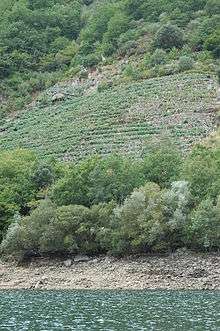Albariño
Albariño (Galician pronunciation: [alβaˈɾiɲʊ]) or Alvarinho (Portuguese: [aɫvaˈɾiɲu]) is a variety of white wine grape grown in Galicia (northwest Spain), Monção and Melgaço (northwest Portugal), where it is used to make varietal white wines. Albariño is the Galician name for the grape; in Portugal it is known as Alvarinho, and sometimes as Cainho Branco.[1]
| Albariño | |
|---|---|
| Grape (Vitis) | |
Bunch of Albariño grapes | |
| Color of berry skin | Blanc |
| Species | Vitis vinifera |
| Also called | Alvarinho and other synonyms |
| Origin | Galicia and Portugal |
| Notable regions | Galicia, Spain; Minho, Portugal |
| Notable wines | Rías Baixas, Vinho Verde (Vinho Alvarino) |
| VIVC number | 15689 |
It was presumably brought to Iberia by Cluny monks in the twelfth century. In Galician, its name "Albariño" comes from albar, and this from albo, both meaning "white, whitish" (and in Portuguese "Alvarinho" "Alvarano" from alvar and alvo), and those from Latin albus, "white"[2]. It has locally been thought to be a Riesling clone originating from the Alsace region of France, although earliest known records of Riesling as a grape variety date from the 15th, rather than the 12th, century. It is also theorized that the grape is a close relative of the French grape Petit Manseng.[3]
It should not be confused with the Alvarinho Liláz grape of Madeira.
Major regions
Spain produces Albariño to a significant degree in the Rías Baixas DO, especially in the town of Cambados, Condado do Tea and in Barbanza e Iria.[4] It is also common in the Vinho Verde region of Portugal, but it is only authorized to be grown in Monção and Melgaço. In other locations such as Ribeiro, Lima, Braga or Valdeorras it is often mixed with other grapes such as Loureiro, Godello, Caiño, Arinto or Treixadura to produce blended wines. Such blends were common throughout Galicia too until about 1985; when the Rías Baixas DO was established on an experimental basis in 1986, Albariño began to emerge as a variety, both locally and internationally.[5] Its recent emergence as a variety led the wines to be "crafted for the palates of Europe, America and beyond and for wine drinkers who wanted clean flavors and rich, ripe fruit" and led to wines completely different from those produced across the river in Portugal.[5]
Albariño is now produced in several California regions including the Santa Ynez Valley, Clarksburg, Napa, Edna Valley and Los Carneros AVAs.[6] Albariño is also produced in Oregon, first by Abacela Winery[7] in the Umpqua Valley AVA,[8] and in Washington state.[9]
In recent years Albariño attracted the attention of Australian winemakers, several of whom are now producing varietal wines. However, it has recently been discovered that grape growers and wine makers in Australia have been supplying and selling wrongly labelled Albarino for over a decade. They thought they were pouring money into the market for the Spanish grape, only to discover they were incorrectly sold cuttings of the French Savagnin grape instead.
A French expert visiting Australia raised questions in 2008, and DNA testing confirmed that the grapes are in fact French Savagnin. Almost all wine in Australia labelled as Albarino is Savagnin.[10]
Wine characteristics
The grape is noted for its distinctive botanical aroma with a citrous undertone, very similar to that of Viognier, Gewurztraminer, and Petit Manseng, suggesting apricot and peach. The wine produced is unusually light, and generally high in acidity with alcohol levels of 11.5–12.5%.[4] Its thick skins and large number of pips can cause residual bitterness.
Viticulture

For hundreds of years, Albariño vines could be found growing around the trunks of poplar trees and in bushes along the outside margins of a field. A practice which some growers still use in Portugal's Vinho Verde region. However, in the middle of the century, the growers made big investments and became professional grape growers.[11] In Vinho Verde, the vines are typically trained on high pergolas, which encourages over-cropping, often leading to grapes that are unable to exceed more than 8.5% potential alcohol.[12] When grown in a vineyard, the vines need to be wire trained with large canopies to accommodate the 30 to 40 buds per vine that is typical. The grape responds well to the heat and humidity though the high yields and bunching of clusters usually keeps the grapes within the margins of ripeness.[4]
Synonyms
Albariño is also known under the synonyms Albarina, Alvarin Blanco, Alvarinha, Alvarinho, Azal Blanco, Galego and Galeguinho.[13]
See also
References
- Oz Clarke Encyclopedia of Grapes pg 37 Harcourt Books 2001 ISBN 0-15-100714-4
- Gran Diccionario Xerais da Lingua and Diccionario Galego de Ir Indo for Galician; Dicionário Houaiss da Língua Portuguesa and Dicionário Estraviz de Sotelo Branco for Portuguese
- Oz Clarke Encyclopedia of Grapes pg 167 Harcourt Books 2001 ISBN 0-15-100714-4
- Oz Clarke Encyclopedia of Grapes pg 36 Harcourt Books 2001 ISBN 0-15-100714-4
- Split Personality Archived 2004-06-04 at the Wayback Machine, a December 2002 Wine Spectator article (registration required to read archived article)
- http://www.appellationamerica.com/grape-varietal/Albarino.html
- "Abacela". www.abacela.com. Retrieved 6 April 2018.
- "Umpqua Valley Winegrowers - The Umpqua Valley". www.umpquavalleywineries.org. Retrieved 6 April 2018.
- "Getting to Know Oregon and Washington Albariño". jamesonfink.com. 16 July 2014. Retrieved 6 April 2018.
- White, Leslie (April 15, 2009). "White wine fiasco". The Weekly Times. Retrieved 2010-05-11.
- Garrido, João; Mota, Teresa.Manual Técnico, Comissão de Viticultura dos Vinhos Verdes, 2004
- Clarke, Oz (2008). Grapes and Wines. Pavilion Books. p. 36. ISBN 978 1 862058354.
- Alvharinho Archived 2012-03-24 at the Wayback Machine, Vitis International Variety Catalogue, accessed 2010-11-23
